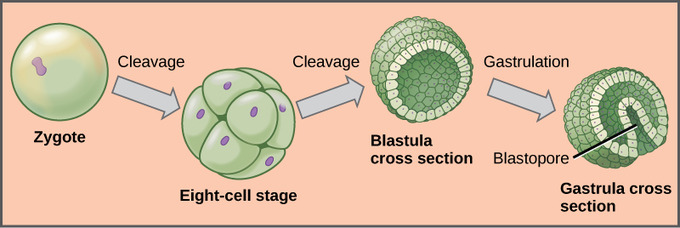Yeah, you. And me… and every human being… and really, every vertebrate… By meatbag, I mean that you’re basically a bag within a bag within a bag (and so on) of flesh. Once a blob of cells, you were rearranged into compartments, with cordoned-off sections of skin, muscle, brain, nerves, blood vessels, bones, organs, some other fiddly bits, and the all-encompassing fascia.
Fascia (FAH-sha) is the bag, in a sense, and it is enrobing every single element in your body. It is so important yet minimally understood or studied (like so many things in this world). To get the basic idea of how your fascia came to be, consider the start of your life in the womb.

First, you were two cells that came together; a sperm and egg. Those cells divided into a little mass, then organized into a sphere, which became a tube within a tube.

Your digestive tract formed with endoderm (an inner tube from mouth to anus), your brain and spinal cord formed with ectoderm (another tube), and then a surround of ectoderm (your skin and brain are made of the same layer). Between all that forms the mesoderm, developing into tissue like bones, muscles, and blood. Everything else is differentiated from there. Fascia is surrounding every structure in a “double-bag.” So what is it exactly?

Fascia is a network of tissue that extends throughout all three embryonic layers, which is why it can be seen as a single unit, or fascial net. A decent way to think of the fascial net is like the circulatory system or nervous system, which also spread throughout the body, carrying signals and connecting other tissues.

A unique aspect of the fascial net is its structural ability to vary tension, like a sailboat with a crew, helping you to be able to tense and relax your muscles in concert, to perform actions such as walking without falling over. Each muscle compartment, each cell, communicates with the others, defying our historical reductionist understanding that “a muscle is a single unit that moves and connects two bones.” It’s so much more than that.
So what? The fascial net composes many meridians or trains, as written about in Thomas W. Myers’ book, Anatomy Trains. These trains run in specific directions to create paths of continuity relevant to movement, pain, function, and circulation. For me and other physicians and body-workers, these trains can really inform a lot of our understanding of the body as a whole unit. I’ll talk about the trains themselves in my next post.
I hope that this post piques your interest in this book as it is becoming an invaluable tool for my own practice.
Check out https://www.anatomytrains.com for more information.



One thought on “Hey Meatbag!”